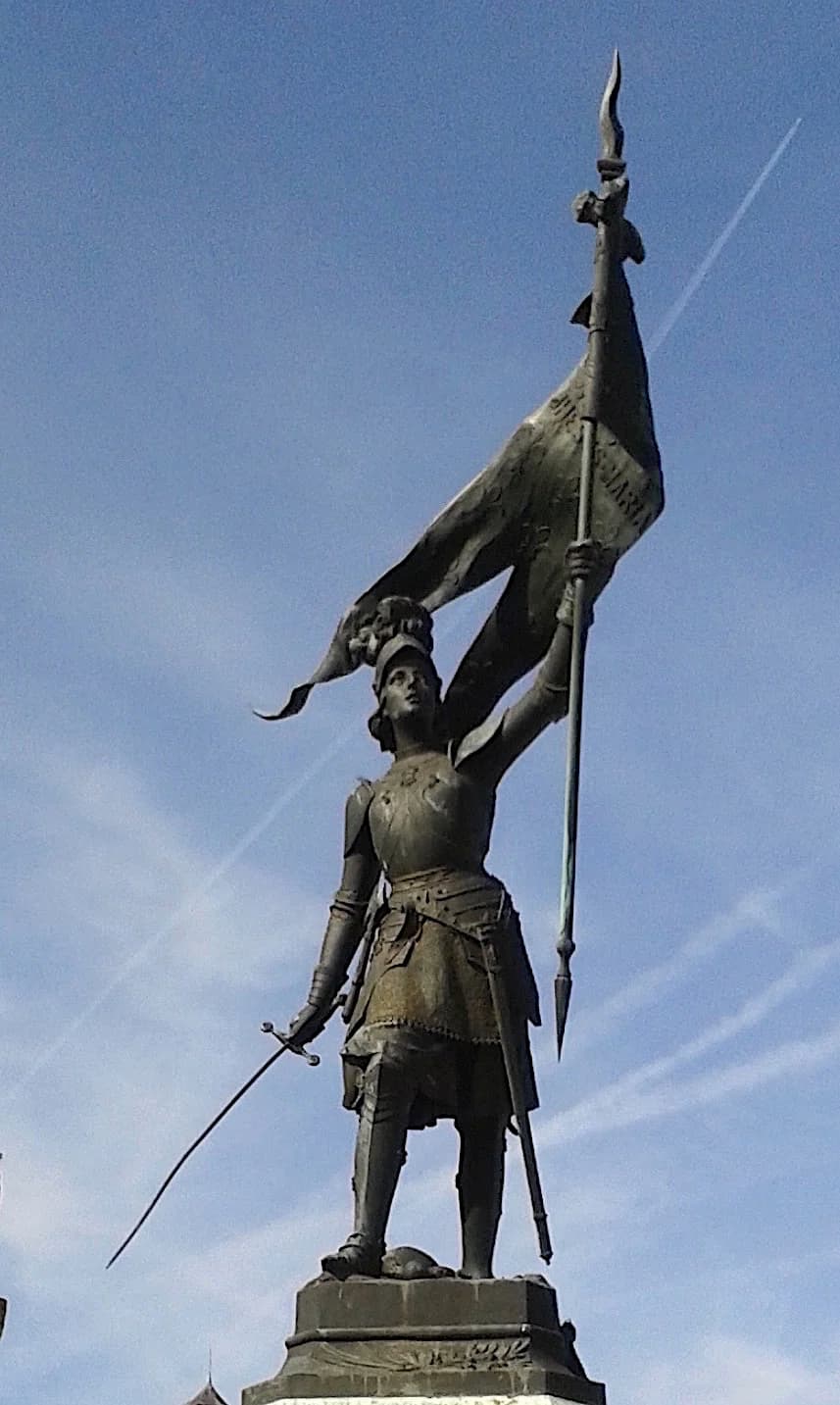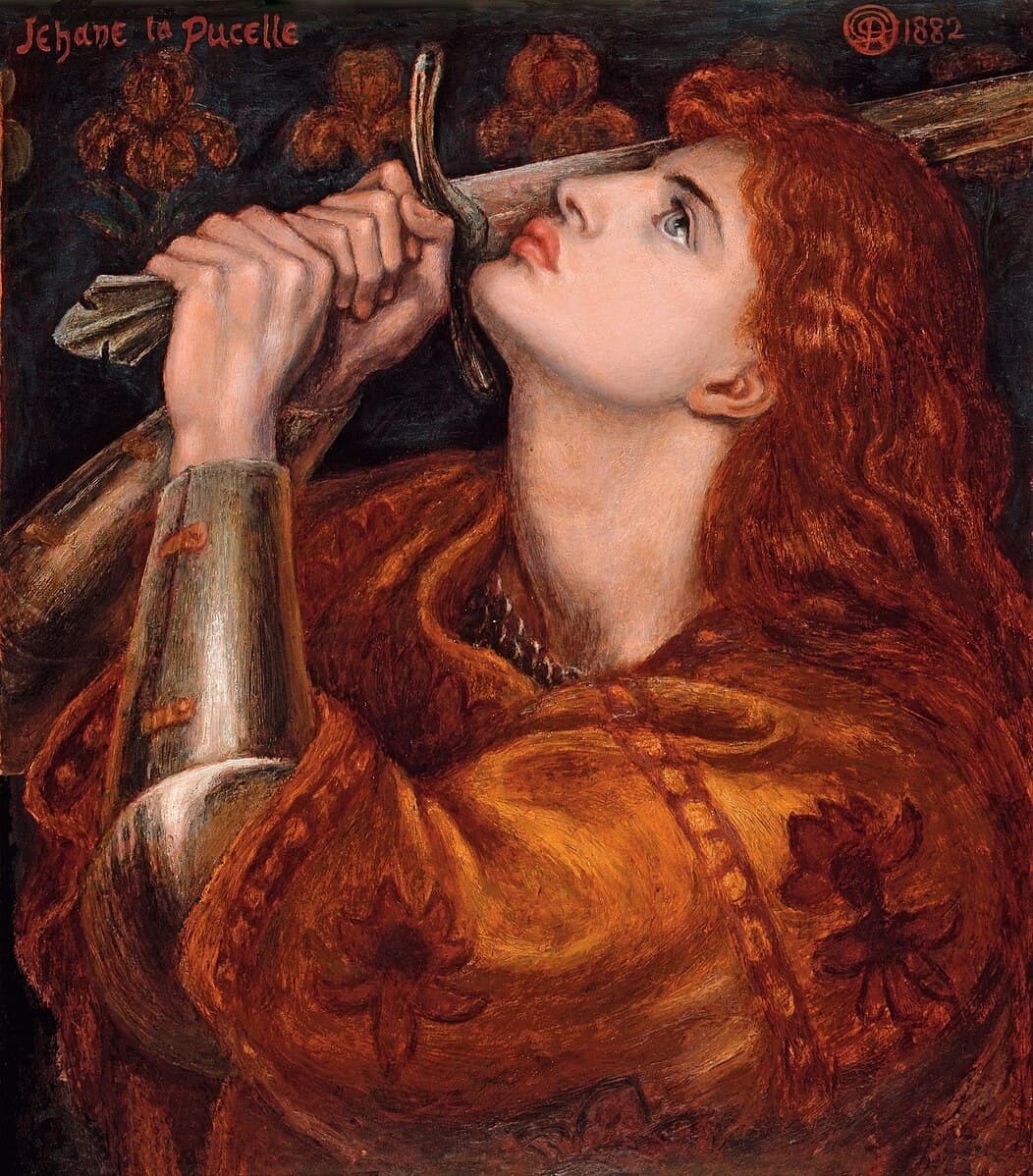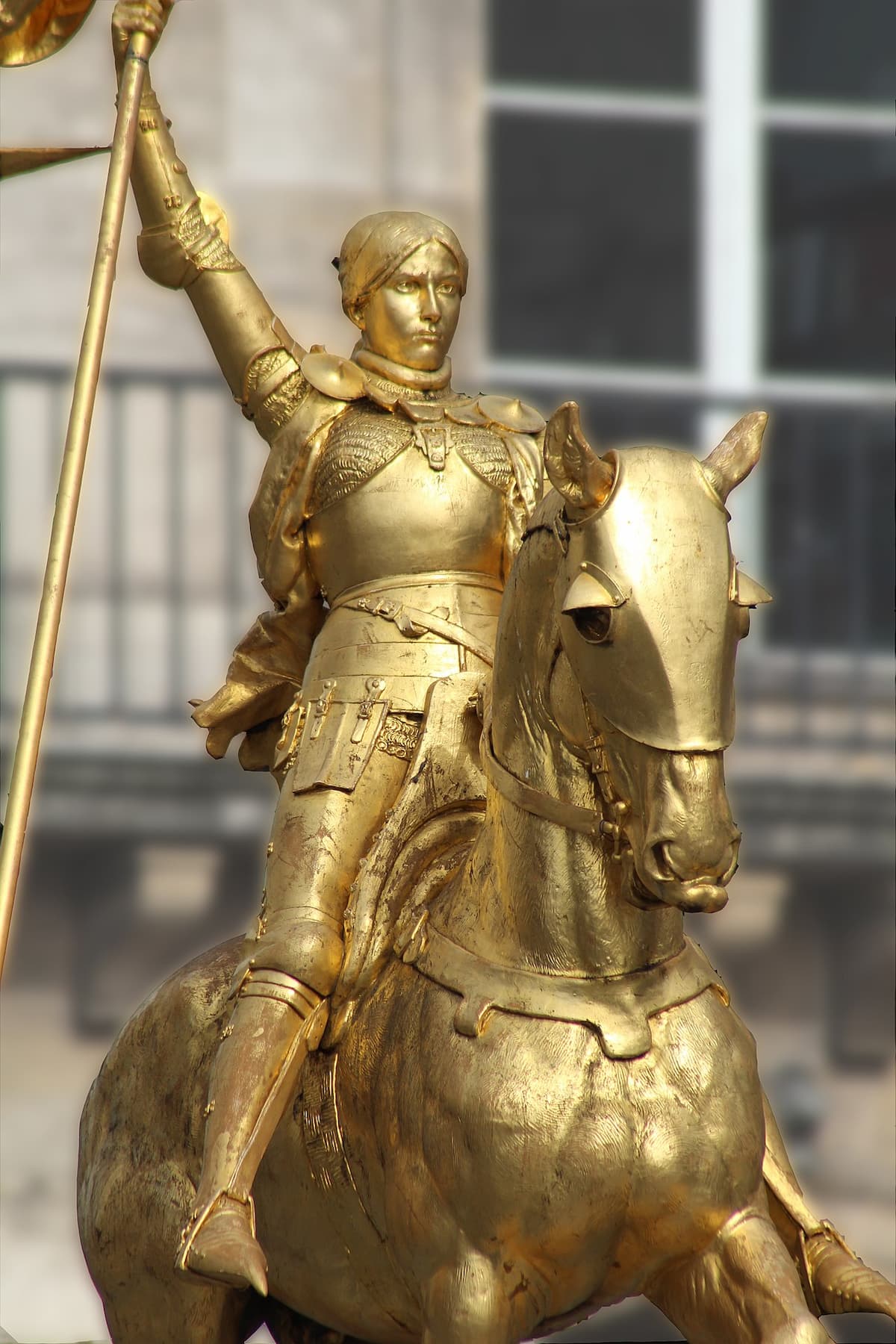Joan of Arc, also known as the “Maid of Orléans,” was declared a national symbol of France by Napoleon in 1830. Her story had a profound effect on French society as the old societal order gave way to new ideas about nationhood and the dignity of the common person. Joan of Arc became a natural symbol of both.

Joan of Arc Statue, Beaugency
Joan of Arc was born in January 1412 in a small town in north-eastern France, with the exact date of birth still hotly debated. According to the story, she received divine instruction at the age of 13 that told her to drive the English from the country. The illiterate farm girl supposedly predicted the outcome of a battle, and she joined Charles of Orléans and advised French military leaders.
Carrying a banner she rallied the troops and helped to liberate the city of Orléans from the English. With her help, Charles drove out the English and Burgundian from the Loire Valley and liberated Reims, where Charles took his crown. Joan of Arc was subsequently captured and put on trial, and convicted by the English, and she was burned at the stake in Rouen on 30 May 1431. She would later become a Roman Catholic saint and inspire countless musical settings. To celebrate her birthday, let’s have a listen to some of these musical creations.
Kermit Poling: String Suite No. 2, “Along These Footsteps to Paradise” (Joan of Arc) (London Symphony Orchestra; Kermit Poling, cond.)
According to research by Elizabeth Dister, “when a French historian attempted to count all the musical homages dedicated to Joan of Arc in 1894, he catalogued about 500.” However, in the first half of the 20th century, the French musical mania for Joan only increased, “fuelled by her canonisation in 1920 and 500-year anniversary of her martyrdom in 1931.”
The young maiden who became a symbol of self-sacrifice for her country certainly fired Pyotr Il’yich Tchaikovsky’s imagination while he was still a child. At the age of six, he wrote a poem entitled “The Heroine of France,“ and thirty years later, he again turned to the subject by writing his own libretto for an opera. It was not an easy task, as he struggled to find a rhyme and the correct number of syllables to know what each character should be saying at that moment.
Composing the music was also difficult for Tchaikovsky, as he wrote to Nadezhda von Meck. “It makes me want to write and write as quickly as possible; so many ideas keep flowing into my head that there is already no room there. My human frailty drives me to despair and the melancholy thought of all the long days, weeks, and months necessary to do it all, think about and write it; how I wish it could all be finished immediately with one stroke of the pen.”

Joan of Arc at the Stake
Pyotr Il’yich Tchaikovsky: The Maid of Orleans, Op. 4 (Vitali Ignatievich Kilchevsky, vocals; Nicolai Konstantinov, vocals; Sofya Preobrazhenskaya, mezzo-soprano; Odilia Kashevarova, vocals; Vitali Runovsky, vocals; L. Solomiak, vocals; Vladimir Ulianov, vocals; Ivan Yashugin, bass; I. Shashkov, vocals; S. Vodsinsky, vocals; A. Marin, vocals; M. Merzhevskaya, vocals; N. Grishanov, vocals; Kirov State Academic Theatre Chorus; Kirov State Academic Theatre Orchestra; Boris Khaykin, cond.))
The opera was fully drafted in Paris by the end of February 1879, and the full score was completed in August at his home in Russia. The premiere of The Maid of Orleans took place at the Mariinsky Theatre on 13 (25) February 1881, but it was withdrawn from the repertoire of the Saint Petersburg theatres a year later. Tchaikovsky received countless requests to rework the score, including the transposition of Joan’s part for mezzo-soprano. Although it was the first of Tchaikovsky’s operas to be staged outside Russia, it really never caught on.
Tchaikovsky had, of course, been aware that the “Maid of Orleans” had already been the subject of operatic treatment by Giuseppe Verdi. Both had based their accounts loosely on Friedrich Schiller’s 5-act tragedy “Die Jungfrau von Orleans.” However, Schiller’s tale introduced a romantic element to the story. When Joan is about to kill an English knight, she removes his helmet and immediately falls in love with him.
Verdi’s librettist Temistocle Solera centered the plot on this romantic relationship, casting Joan as the soprano in opposition to an awkward romantic partner. Giovanna d’Arco, cast in the operatic tradition of the 19th century, was initially a great success, but it almost completely disappeared 20 years later. It became a huge Nazi propaganda spectacle with a newly translated and adapted libretto. Dister tells us that neither Verdi nor Tchaikovsky’s opera has been successful in France, “as Joan of Arc was famously plain-spoken, simple, and immune to sensuality, and so French listeners have found it altogether off-putting to watch her indulge in coloratura runs and trills while frolicking about the stage with a romantic partner.”
Giuseppe Verdi: Giovanna d’Arco (Jessica Pratt, soprano; Jean-Francois Borras, tenor; Julian Kim, baritone; Roberto Cervellera, tenor; Emanuele Cordaro, bass; Bari Teatro Petruzzelli Chorus; Orchestra Internazionale d’Italia; Riccardo Frizza, cond.)

Dante Gabriel Rossetti: Joan of Arc, 1882
Jeanne au bûcher, the dramatic oratorio by Arthur Honegger, however, has received regular performances in France and across the globe. The work was commissioned by the famed Russian dancer and art patron Ida Rubinstein, who intended it to be part of a “tetralogy of evil.” Additional parts with music by Milhaud and Stravinsky fell victim to the outbreak of the Second World War.
The verse drama was created by Paul Claudel, who was nominated for the Nobel Prize in Literature in six different years. Once combined with the music by Swiss composer Arthur Honegger, a prominent member of “Les Six,” the result is a rather curious hybrid of oratorio, melodrama, and film music featuring an adult choir, children’s choirs, and singers. The music is certainly eclectic and inclusive, and ranges from atonality to 1920s jazz, with military fanfares and Hollywood-like melodic sweeps punctuating the storyline throughout.
Honegger’s imaginative instrumentation also includes three saxophones and an “Ondes Martenot” to create a vibrant, ethereal, and unique sound world. When I first listened to the work, I was very surprised that Joan of Arc does not sing but speaks. One reason, perhaps, is the fact that the work was commissioned for performance by an actress, not a singer, but as Dister explains, “Honegger and Claudel’s work fits squarely within the so-called johannique tradition; Joan almost never sings in these sorts of works.”
Arthur Honegger: Jeanne au bûcher, (excerpt)
Claudel’s dramatic structure takes advantage of a known psychological phenomenon, as a dying individual sees a sequence of images from their life flash by in the final seconds. His drama takes place during Jeanne d’Arc’s final minutes at the stake. 11 scenes, which unfold without a break and are dramatically independent of each other, provide flashbacks to the heroine’s younger days and her trial.
In his incidental music for Jules Barbier’s stage play Jeanne d’Arc, Charles Gounod conjures a soundscape “ that had developed over the 19th century and was used over and over in the century that followed. Essentially, it is an intermixture of sonic elements, blending orchestral accompaniment and speech, choral singing and vocal solos and duets. We hear a triumphant coronation march, a doleful funeral march, borrowings from Gregorian chant, and plenty of pseudo-medieval music.”

Statue of Joan of Arc in Paris
As explained by Dister, “Gounod also used deliberately archaic-sounding music to try to plunge the audience into Joan’s time, employing some pseudo-medieval minstrel singing and a Baroque-sounding minuet, evidently unconcerned with anachronism.” And while you might not have heard the entire work, I am pretty sure you are familiar with the “Meditation,” one of the most frequently arranged excerpts.
Charles Gounod: Jeanne d’Arc, “Meditation” (arr. for violin and piano) (Semmy Stahlhammer, violin; Ivetta Irkha, piano)
The conductor, organist and composer Paul Paray (1886-1979) took Joan of Arc into a different context altogether. In 1931, to commemorate the 500th anniversary of the death of Joan of Arc, he decided to compose a mass. Premiered at the cathedral in Rouen, the work paved his way for appointments in Colonne, New York City, and eventually to an appointment at the Detroit Symphony Orchestra.
It was certainly no easy task to take a historical, mystical, and mythical story from 500 years ago, and a story that had become a national epic, and place it within the context of a mass. Paray’s deliberate use of the Latin language placed the work within classical conservatism, which “signalled Frenchness and a civilized Greco-Roman tradition in contrast to the bombastic and barbaric German style.”
Paul Paray: Mass of Joan of Arc (Lorna Haywood, soprano; Terry Patrick-Harris, alto; Joseph Harris, tenor; Jozik Koc, baritone; Royal Scottish National Orchestra Chorus; Royal Scottish National Orchestra; James Paul, cond.)
The legend of Joan of Arc continues to inspire, and composer/performer Jay Cloidt and writer/singer Amanda Moody have collaborated on the theatre piece D’Arc: Woman on Fire. This contemporary re-imagining sees Joan of Arc interceding into the life of a contemporary mother whose daughter vanished while working abroad in a war-torn region.
The music includes a newly-written hymn setting of 14th-century lyrics and delicate acoustic duets with cello parts performed by ex-Kronos Quartet cellist Joan Jeanrenaud. It also features pretty intense electronic music with lyrics set at an extremely wide range of vernacular styles and pretty abstract electronic textures. Critics call the music “intense and intelligent, yet emotional and entirely accessible.” If you excuse the pun, Joan of Arc has lost none of her fire.
For more of the best in classical music, sign up for our E-Newsletter
Jay Cloidt/Amanda Moody: D’Arc “Woman on Fire” (Amanda Moody, vocals; Joan Jeanrenaud, cello; Jay Cloidt, electronics)

